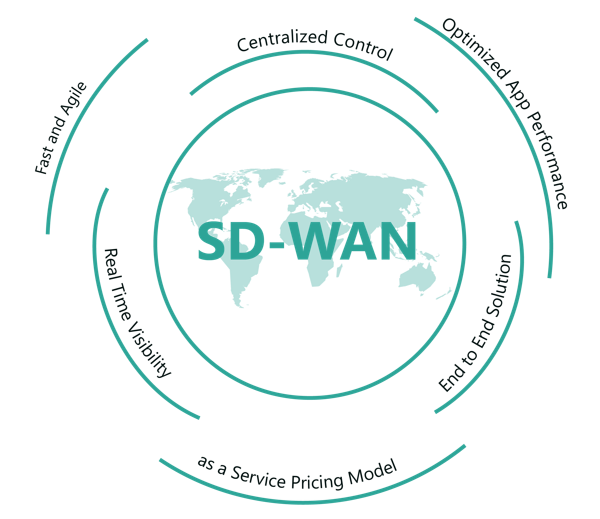CLOUD SERVICES / SAAS and OFFICE 365
As interest in leveraging public cloud computing services and SaaS such as Microsoft Office 365 increases, WAN managers need to be able to support these initiatives, while still maintaining the network security, visibility and control they and their management have come to expect.
The trend to consolidate applications and servers to a small number of data centers further from the end users who are accessing them is only being accelerated with the introduction of cloud services. Software-as-a-Service (SaaS) and public cloud services are ways for enterprises to save on CapEx and OpEx and take advantage of innovations happening in the cloud – and also best take advantage of the scarce time and talents of the limited number of on-staff skilled IT professionals.
Cloud adoption is on the rise across market sectors. 451 Research believes that the worldwide cloud computing spending will expand at a 36 percent compound annual growth rate (CAGR) through 2016 to $19.5 billion. Gartner forecasts that by 2016 the majority of IT spending will be on cloud tools and services.
WAN Managers face a growing demand for network services – with whatever combination of private data centers, public cloud access and SaaS – need not just more bandwidth on their WAN, but also application acceleration, reliability and performance predictability.
Aryaka offers just such an approach, with a single multi-tenant, secure platform, designed from the ground up to provide accelerated, predictable performance inside and outside the firewall to both internal and cloud-based applications – delivered as a no CapEx, fully managed, monthly service.
WOC vendor cloud service approaches
Attempts from purchased WAN Optimization Controller (WOC) vendors to address the issue of accelerated cloud services access fall into two camps. Virtual WOCs, where an instance of the dual-ended, symmetric WOC software is run as a virtual appliance at the cloud vendor location, have two substantial limitations. While they can reduce bandwidth consumption when accessing, say, applications run by a customer at Amazon Web Services, they are not a solution for SaaS offerings like Office 365. Worse still, they don’t address the biggest performance problem – the network itself, and the congestion-based latency and packet loss problems that occur on the public Internet
An alternative approach by one leading WOC vendor is an add-on to their purchased WOC solutions via a partnership with a leading Content Delivery Network provider. While better than the virtual WOC approach, this solution too has multiple problems. It is expensive. It supports only a very limited set of SaaS and cloud service offerings. It requires customers to continue to pay for and maintain dual networks. It recommends “trombone” access from enterprise site through enterprise data center before delivering its accelerated access to the cloud service, slowing application performance, sometimes substantially, compared to more direct access over an Internet connection. It depends on the use of distributed servers in the cloud that are shared with consumer traffic, which can sometimes reduce rather than improve performance. And while it attempts to deal with some network performance issues, it still ultimately leaves your traffic at the mercy of the public Internet to access cloud locations.
The Aryaka solution
Aryaka offers a better answer with our groundbreaking WAN Optimization-as-a-Service and Cloud Network as-a-Service solutions. They combine cloud-based, purpose-built WAN Optimization technology with enterprise-grade connectivity utilizing a dedicated reliable, MPLS-like core network based on globally distributed POPs, and centralized WAN and application-layer visibility.
With a unique, multi-segment architecture, you get a single solution offering LAN-like performance over the WAN without the high cost of MPLS or the cost and hassle of purchased WAN Optimization appliance solutions, all in a fully managed, no CapEx monthly service. And it’s been designed from the ground up to accelerate access to private enterprise sites and SaaS / cloud services alike.
The linchpin of Aryaka’s approach is a dedicated reliable, low latency core network with built-in diversity and redundancy based on POPs distributed close to end user locations. POP locations are selected based on customer proximity, network and geographical diversity, and location of peering points to best deliver predictable and reliable high application performance. Together with these POPs, the multi-segment architecture minimizes the impact of packet loss on the first/last mile when it does occur, delivering optimized, predictable performance.
This POP-based approach means that the same technology and same network used for connecting enterprise locations to each other is used to deliver accelerated, predictable performance to cloud-based services. Cloud service traffic like Office 365 flows over the Aryaka network from the enterprise location to the POP closest to the cloud server. For public cloud / SaaS access, the Aryaka POP will do NAT translation from customers’ private IP addressing to public addresses.
The ability to leverage the Aryaka core network enables much better performance cloud access crossing an ocean, and more predictable performance for all users all the time compared with using the unaided public Internet or any kind of “virtual WOC in the cloud” approach.
With Aryaka services, unlike competing approaches, customers need not “trombone” their Office 365 traffic through an enterprise data center, slowing access. Yet bandwidth-scaling benefits, typically as high as 70% – 90%, are still obtained with traffic going over each customer location’s Internet link to the closest Aryaka POP, and then directed across the private network to the cloud service.
In addition to the bandwidth savings, application speed-ups of 3 – 10x are frequently seen. The benefits are more pronounced when access is from users across an ocean from the Office 365 server hosting the customer’s data. Aryaka’s private, MPLS-like core network helps accelerate performance for real-time and interactive applications like remote desktop or Office 365 Lync more than any technology on distant WOC appliances – virtual or physical – can do.
Aryaka’s is the ideal solution for enterprises looking to migrate more of their applications to cloud services and SaaS providers without sacrificing performance or network predictability, reliability and visibility. It supports all SaaS and cloud services – large players like Microsoft Office 365, Amazon Web Services (AWS) and Google Apps, as well as any smaller public, and even private or hybrid cloud solutions.






